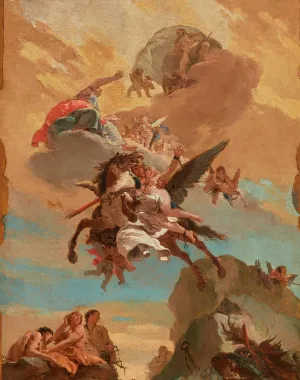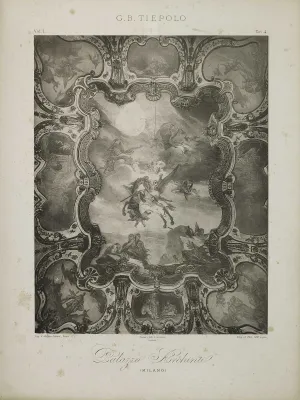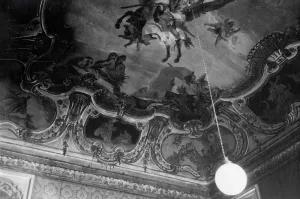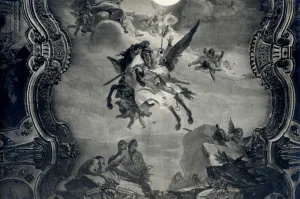Perseus and Andromeda
In Book IV of the Metamorphoses, Ovid recounts the tale of the young and beautiful Andromeda, daughter of the Aethiopian king Cepheus and Cassiopeia. Boasting that Andromeda is more beautiful than the Nereids, Cassiopeia angers Neptune, who, in revenge, sends a monster to ravage the coast of Aethiopia. Told that the only way to save their country is to sacrifice their daughter to the creature, Andromeda’s parents chain her to a rock by the sea. The hero Perseus, son of Jupiter and Danaë, sees Andromeda while flying over Aethiopia and falls in love with her. He asks her parents for permission to marry her if he is able to save her; he subsequently kills the sea monster and rescues Andromeda.
On one of the Archinto ceilings, Tiepolo represented this subject surrounded by eight smaller mythological scenes. The fresco was set in elaborate stucco decorations, possibly created by a team of stucco workers and in a style close to that of Giovan Battista Aliprandi (1665–1720), who was responsible for introducing the French taste for stucco to Milan.
Giambattista Tiepolo (1696–1770)
Perseus and Andromeda, ca. 1730–31
Oil on canvas
20 3/8 x 16 in. (51.8 x 40.6 cm)
The Frick Collection, New York
© The Frick Collection
Tiepolo took liberties with Ovid's Metamorphoses in showing Perseus riding the winged horse Pegasus instead of flying by way of a pair of winged sandals, as in the original text. At the bottom is the rock on which Andromeda was chained, with remnants of her shackles still attached to it. In the sea below is the dying monster, with Perseus's lance — which has shattered upon piercing its head — above its eye. To the left, and behind the rock, are five Nereids, crying, presumably for the death of the monster, as well as from the humiliation suffered because of Cassiopeia's comments.
Giambattista Tiepolo (1696–1770)
Perseus and Andromeda, ca. 1730-31 (destroyed 1943)
From Attilio Centelli and Gerardo Molfese, Gli affreschi di G.B. Tiepolo raccolti da Gerardo Molfese con uno studio di Attilio Centelli (Turin, 1897), pl. 4
Page from unbound book
23 1/2 × 17 5/8 in. (598 × 448 mm)
Azienda di Servizi alla Persona Golgi-Redaelli, Milan
su autorizzazione dell'Azienda di Servizi alla Persona Golgi-Redaelli di Milano
The overall configuration of the Perseus and Andromeda fresco in Palazzo Archinto was very similar to the one shown in the sketch, which was likely presented to Carlo Archinto for approval. There were, however, some significant changes. The position of the proper right arm of the central Nereid was altered, and two additional figures were added in the final fresco. To the left of Cassiopeia, a crowned male figure was included — Cepheus — and the god Mercury was added below Jupiter.
Giambattista Tiepolo (1696–1770)
Perseus and Andromeda (detail), ca. 1730–31 (destroyed 1943)
Unknown photographer, 1940
4 3/8 × 6 3/4 in. (112 × 172 mm)
Azienda di Servizi alla Persona Golgi-Redaelli, Milan
su autorizzazione dell'Azienda di Servizi alla Persona Golgi-Redaelli di Milano
Giambattista Tiepolo (1696–1770)
Perseus and Andromeda (detail), ca. 1730–31 (destroyed 1943)
Unknown photographer, 1940
4 3/8 × 6 3/4 in. (112 × 172 mm)
Azienda di Servizi alla Persona Golgi-Redaelli, Milan
su autorizzazione dell'Azienda di Servizi alla Persona Golgi-Redaelli di Milano




